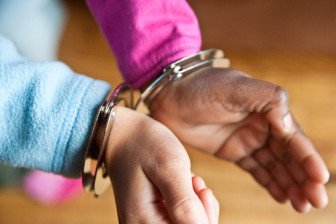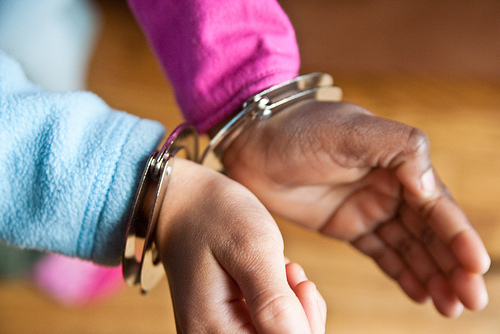
stevendepolo / Flickr (license: http://creativecommons.org/licenses/by/2.0/)
WASHINGTON – In the ABC News video, the white youth and the black youth both appear to be trying to do the same thing: steal a bike in broad daylight in a community park. But the two actors playing thieves, both filmed by hidden cameras at different times, get decidedly different reactions from passers-by.
The white youth hammers and saws at the chain securing the bike before bringing out bolt cutters to try to cut the chain.
“Do you happen to know whose bike it is?” he asks one observer.
Lots of people stare, and one asks if it’s his bike, to which he responds, “Technically, no.”
Within about an hour, more than 100 people pass by, and only one couple tries to stop him.
One African-American woman tells ABC News she thought maybe he worked for the park.
When the network – on its show “What Would You Do?” – replaces the white actor with a similarly dressed black actor who then appears to be trying to steal the bike, he’s confronted right away by passers-by who ask if it’s his bike. One man pulls out a cell phone to call 911, while another snaps photos.
“Excuse me, sir, but the bike’s been here for days; no one’s going take it,” the black youngster says.
The video illustrates bias perhaps better than a stack of studies could do, and it led to spirited discussion Tuesday at a workshop on confronting racial and ethnic bias in the juvenile justice system at the John D. and Catherine T. MacArthur Foundation’s eighth annual Models for Change National Working Conference.
Whether through “disproportionate minority contact” or unequal treatment in the juvenile judicial process, young people of color often face bias, panelists and audience members agreed.
Panelist Jason Szanyi, a staff attorney at the Washington-based Center for Children's Law and Policy who works with jurisdictions to reduce racial and ethnic bias in the juvenile justice system, said the video made its intended point.
“I think that one of the big messages was you could have people in an identical situation engaged in identical behavior in an identical location wearing the same clothes responding to people in the same way, and you can have an incredibly different response to that just based on how the kid looks and the color of his or her skin,” Szanyi told JJIE.org after the workshop.
The workshop examined ways to reduce bias, particularly by focusing on several studies showing bias among some law enforcement, judges and probation officers.
The idea is the findings of the research will be a way to start discussions about bias among workshop audience members, who were juvenile justice professionals.
That can mean breaking the silence on bias against youths of color.
“Sometimes, there can be a culture of politeness where it’s just an uncomfortable issue, and folks can see that there’s a problem, but nobody wants to point fingers or call anybody out,” Szanyi said. “And the research can be a vehicle for saying, ‘This is what we know from these studies about probation officers and about judges and about law enforcement.’
“So the studies can be a vehicle to get past either cultural politeness or just a struggle to start the dialogue by bringing something in that isn’t specific to that jurisdiction [but] that obviously has implications for all of us who are doing work at various points in the system.”
Panelist Larry Spottsville, director of Juvenile Services for the 9th Judicial District Court for Rapides Parish, La., suggested designating someone in a jurisdiction to help oversee and coordinate efforts to prevent bias.
“My personal view from my experience in doing this work is that if you have not found what we call a champion in your jurisdiction that wouldn’t mind discussing the tough issues to address the strategic approaches, you have to have someone that’s going to step forward,” Spottsville said.
“You have to find that champion, that person that wants to step forth and honestly do this work.”
In his jurisdiction, he said, a white female judge played that role, addressing ways to reduce bias among law enforcement, the courts, the schools and the community.
Spottsville also said a jurisdiction should put together a strong DMC team to develop strategies.
Other workshops at the two-day MacArthur Foundation conference focused on a broad array of juvenile justice issues. Among them:
-
Establishing alternatives to arrest for minor offenses: Schools in Sedgwick County, Kan., adopted two memorandums of understanding to reduce arrests at schools for minor offenses. One of the memos dealt with students with disabilities, while the other included an alternative to arrest for all students in Wichita public schools.
-
Relying on confinement as a last resort for juvenile offenders: Toward this end, Illinois took steps including shifting fiscal incentives and revising a statute to highlight the existing standard of confinement as a last resort.
-
Improving outcomes for youths involved in the juvenile justice and child welfare systems: The Robert F. Kennedy National Resource Center for Juvenile Justice is striving to help coordinate the work of the child welfare, juvenile justice, education and behavioral health systems.
-
Giving youths a bigger voice in juvenile justice reform: This workshop highlighted reform efforts in Washington state stressing the inclusion of young people in advocacy efforts, which gives leaders perspective to make changes while helping prepare the youths to become advocates.
-
Keeping status offenders out of court: Status offenses include truancy, running away from home and drinking alcohol, which are offenses only because of the age of the offender. The Center on Youth Justice at the Vera Institute of Justice has launched the online Status Offense Reform Center, a one-stop shop for all things related to status offense reform designed to keep these offenders out of the juvenile justice system. The Coalition for Juvenile Justice recently released its National Standards for the Care of Youth Charged with Status Offenses.
-
Responding to repeat adolescent domestic battery: The Adolescent Domestic Battery Typologies Tool is being validated as a way to measure the risk of a repeated offense and to help determine responses to domestic battery.
-
Banning solitary confinement of youth: This workshop focused on efforts to achieve statewide bans on solitary confinement. A coalition that recently won a $400,000 settlement in a lawsuit against New Jersey over two youths who had been held in solitary confinement says the practice harms the mental health of those subjected to it.
-
Establishing juvenile defense standards: Juvenile defense is often looked down upon in the legal professional and not even viewed by some as a specialized practice. This workshop looked at lessons for the legal profession from California and North Carolina, which have established high standards of practice and specializations in juvenile defense.
-
Improving employment prospects for youths involved in the juvenile justice system: The workshop focused on Youth Futures, which helps juvenile justice-involved youths in Chicago, Los Angeles and New Orleans gain employment through individualized case management linked to workforce development and educational interventions and training programs.
